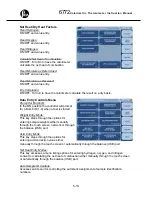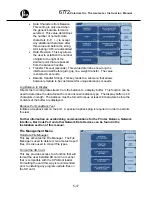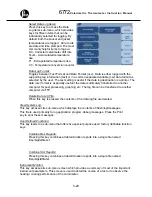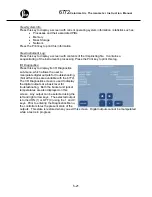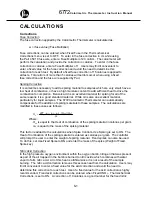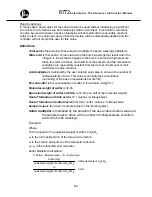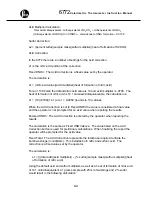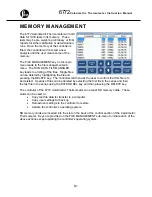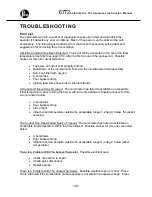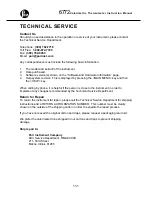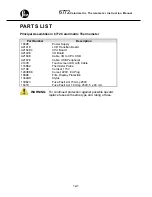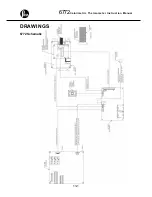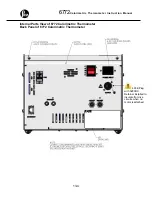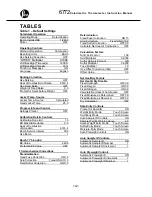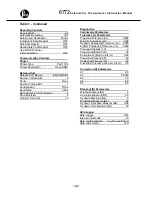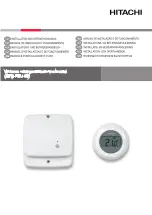
6772
Calorimetric Thermometer Instruction Manual
6-6
ASTM, ISO and Other Methods
Current ASTM, ISO, and British Standard Methods differ on their treatment of the nitric and
sulfuric acid thermochemical corrections. ASTM Methods call for titrating the bomb washings
to determine the total acid present. This is assumed to be all nitric acid with a heat of
combustion of -14.1 Kcal per mole. The amount of sulfur is then determined and converted to
equivalents of sulfuric acid. The difference between the heat of formation of sulfuric acid (-
72.2 Kcal per mole or -36.1 calories per milliequivalent) and nitric acid is then subtracted as
the sulfur correction.
Most other test methods treat nitric and sulfuric acid corrections as entirely separate values
instead of combined values. This eliminates the requirement for a total acid determination
and permits the nitric acid correction to be handled in a variety of ways, including the
assumption of a fixed nitric acid correction.
The 6772 Calorimetric Thermometer can be set up to apply the acid correction by either
the ASTM or ISO convention, as the user prefers. Care must be used to ensure the
proper corrections are applied, and the calculations made are consistent with the
procedure used. See Table 2.
ASTM
In the ASTM treatment, the correction for acid formation assumes that all the acid titrated is
nitric acid. Obviously, if sulfur is present in the sample, which in turn produces sulfuric acid, part
of the correction for the sulfuric acid formed is already included in the ASTM nitric acid
correction (e
1
). This is adjusted by a separate computation based upon the sulfur content of the
sample. An additional correction of 1.37 Kcal must be applied for each gram of sulfur converted
to sulfuric from sulfur dioxide. This is based upon the heat of formation of sulfuric acid, from
sulfur dioxide, under bomb conditions, which is -72.2 Kcal per mole or -36.1 calories per
milliequivalent. But remember, a correction of 14.1 calories per milliequivalent of sulfuric acid is
already included in the ASTM nitric acid correction (e
1
). Therefore the additional correction
which must be applied for sulfur will be the difference between 36.1 and 14.1 or 22.0 calories
per milliequivalent (44.0 Kcal per mole). For convenience, this is expressed, in the ASTM e
2
formula, as 13.7 calories (44.0/32.06) for each percentage point of sulfur per gram of sample.
ISO
Both the ISO 1928 and BSI 1016: Part 5 methods for testing the calorific value of coal and
coke, deal with acid and sulfur corrections in a manner which is somewhat different than
ASTM procedures. The analysis of bomb washings in these methods call for a titration, first
using 0.1N barium hydroxide (V2) followed by filtering, and a second titration using 0.1N
HCL(V1) after 20 ml of a 0.1N sodium carbonate has been added to the filtrate. Table 2 gives
the settings which allow the results of the two titrations, V1 and V2, to be entered into the
controller directly for the calculation of the total acid correction. V1 should be entered at the
prompt for acid and V2 is entered at the prompt for sulfur. The settings in Table 2 assume
that the same procedure is carried out for both standardization and determination. The offset
value is the product of -1, the Heat of Formation of Nitric Acid, the acid multiplier, and the 20
ml of 0.1 N sodium carbonate used in the analysis. The formula used to get the total
correction in calories is as follows:
V1 (Acid Multiplier) (Heat of Formation of Nitric Acid) V2 (Sulfur Multiplier) (Heat of Formation of Sulfuric Acid) + offset value

